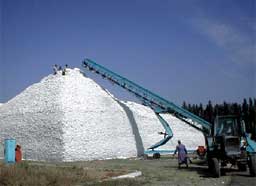DHAKA (Fibre2fashion) – A team of Bangladesh Government officials and businessmen, led by Commerce Secretary Md. Ghulam Hussain, will visit Uzbekistan next month to discuss import of cotton from the CIS country.

- The Government’s overall cotton policy is still aimed at maintaining stable production, and improving quality and fibre characteristics. As of today all state farms have been privatized and reorganized into private farms.
In spite of implementing structural reforms in the agricultural sector, the government still maintains tight control over all aspects of production including planted area, production targets, prices, inputs, procurement and marketing of nearly all of the cotton in Uzbekistan. The local ginning industry has made some improvements in their ginning technology, and as a result ginned lint has less trash content than in the past. About 80-85% of all produced lint is of higher grades with strict and good middling, and the volume of lower grades has decreased.
The cotton ginning industry nevertheless is one of several sectors of the country’s economy where new investments are needed.
The officials will attend the first ever meeting of Bangladesh-Uzbekistan Joint Working Commission for Trade and Economic Cooperation, scheduled to take place in Tashkent from May 5-8, 2012.
At the meeting, import of Uzbekistan cotton by Bangladesh is likely to feature prominently in the discussions.
Steps to further boost exports of Bangladeshi readymade garments (RMG) to Uzbekistan may also be discussed.
During last Bangladeshi fiscal year, the country’s total exports to Uzbekistan were worth US $2.58 million, as pert the data of the Export Promotion Bureau. As in the past few years, China, Bangladesh and Russia are still the major buyers of the Uzbek otton.
The government of Uzbekistan still maintains tight control over all aspects of cotton production, including plantation area, production targets, prices, inputs, procurement and marketing. Despite government efforts to modernize in recent years, Uzbekistan’s cotton ginning industry still consists of predominantly older gins, however due to improving profitability, spinning and weaving industries have invested heavily in new equipment and renovations of existing equipment in recent years. Both domestic and export demand, particularly for cotton yarn, has marginally increased in the past 3-4 years. The textile mills are trying to pursue quality improvements and production diversification to include more value-added products, rather than continuing with low-value yarn based exports. Most mills now understand that they need to be extremely competitive in order to remain active in the shrinking global market. Currently, there are more than 45 joint ventures established in the textile industry with partners from Turkey, Germany, South Korea, Japan and Switzerland. As of 2011, foreign investments in the textile industry exceeded $1.2 billion. The main products produced and exported by textile mills are cotton yarn, gray fabrics and some textile garments.
There are absolutely no changes in the mechanism of cotton exports which still remain under centralized state control.

